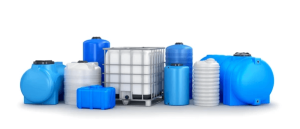Stainless Steel vs. Plastic Storage Tanks
Posted on January 3, 2023 by Cedarstone Industry Team
When it comes to storage tanks for various beverages, stainless steel and plastic are two of the most popular choices. The first one has long been the preferred material for storage tanks, thanks to its durability and resistance to corrosion and other damage. It’s also relatively easy to clean and maintain. On the other hand, plastic storage tanks are generally cheaper, lighter, and more flexible than stainless steel. They also don’t require as much maintenance, although they may not be as durable and can be prone to cracking. Both materials have their advantages and disadvantages, so which one is better?

What are stainless steel tanks? Advantages and disadvantages
Stainless steel tanks are made from sheets of stainless steel that are welded together and then sealed. They’re designed to be highly durable, corrosion resistant, and easy to clean and maintain. The main advantage of stainless steel tanks is their superior durability, which makes them ideal for storing liquids and products that may corrode other materials. Moreover, they’re simply more visually attractive. Want to learn more? Check our article: Stainless steel tanks – taking advantage of the aesthetics.
However, it needs to be mentioned that stainless steel storage tanks are more expensive than plastic solutions and may require more maintenance. Additionally, they can be difficult to move and transport.
What are the advantages of stainless steel tanks?
- Stainless steel tanks are extremely durable and corrosion-resistant,
- They’re easy to clean and maintain,
- They’re visually appealing,
- They have excellent thermal and electrical conductivity,
- They’re non-porous and non-reactive, meaning they will not absorb odors or flavors from the substances they contain,
- They’re strong and can withstand high pressures.
What are the disadvantages?
- They can be expensive to purchase and maintain,
- They’re heavy and difficult to transport,
- They can be susceptible to staining if not properly cleaned,
- They can be difficult to repair if damaged.
So, which ones are better? Stainless steel vs. plastic storage tanks?

What are plastic storage tanks? Advantages and disadvantages
Plastic storage tanks are large, industrial containers made from a variety of plastic materials such as polyethylene and polypropylene. They’re used in a variety of industries to store liquids, gases, and other materials.
What are the advantages of plastic storage tanks?
- Plastic storage tanks are lightweight and durable,
- They can be custom-made to fit a variety of spaces and can be transported easily,
- They’re corrosion-resistant and can be used in a variety of temperatures and pressures,
- They’re cost-effective and require little maintenance.
What are the disadvantages?
- Plastic storage tanks are lightweight and durable,
- They can be custom-made to fit a variety of spaces and can be transported easily,
- They’re corrosion-resistant and can be used in a variety of temperatures and pressures,
- They’re cost-effective and require little maintenance.
What beverages can be stored in the tanks?
Stainless steel and plastic tanks are commonly used to store alcoholic beverages.
Stainless steel tanks are popular for storing beer and wine since they’re corrosion-resistant and have excellent temperature control capabilities. Stainless steel tanks also offer superior hygiene and can withstand the high acidity of wine and beer.
Plastic tanks are also used to store alcoholic beverages, particularly spirits. They’re lightweight and can be easily moved and transported, making them an ideal choice for large-scale operations. Although they’re more affordable than stainless steel tanks (making them a popular choice for those looking to keep costs down), they aren’t as durable.
Which one is better – stainless steel vs. plastic storage tank?
Are you wondering which option is better – a stainless steel vs. plastic storage tank? It really depends on the application, as each type offers its own set of advantages and disadvantages. When making a choice, you should consider the following aspects:
- Durability – stainless steel is a very durable material, resistant to corrosion and extreme temperatures. Plastic storage tanks are noticeably less durable. Additionally, they can be prone to cracking or leaking under certain conditions.
- Set up – stainless steel storage tanks usually require professional installation, but they tend to be more cost-effective in the long run, provided you choose a reliable stainless steel tank manufacturer. On the other hand, plastic storage tanks are easier to install.
- Varieties – both stainless and plastic storage tanks come in a variety of sizes and shapes. Thanks to it, they can be customized to fit specific needs. Therefore, before making up your mind, check out available options and see which ones meets your requirements.
- Shipping costs – it’s one of the main differences between stainless steel vs. plastic storage tanks. As you can probably guess, stainless steel storage tanks are heavier and more expensive to ship than plastic models. However, at the same time, they’re also easier to transport due to their rigid structure. Plastic storage tanks are lighter and can be shipped more cost-effectively, but may need to be reinforced for long-distance transport.
The takeaway
Knowing the differences between stainless steel vs. plastic storage tanks can help you make an informed decision when it comes to storing liquids, beverages and other materials.
If you’re in two minds, remember that stainless steel tanks are generally more durable and corrosion-resistant, but they can be expensive and may require professional installation. On the other hand, plastic storage tanks are lightweight and easier to install, but they’re prone to cracking and leaking.
When making a choice, consider aspects such as the application, durability, set up requirements and available types of storage tanks. Hopefully, this article will help you find a solution tailored to your budget, needs and liquids you want to store.
